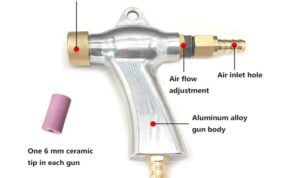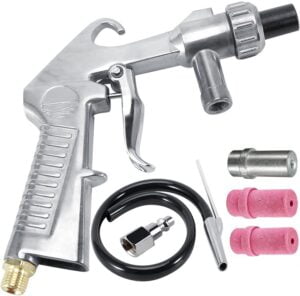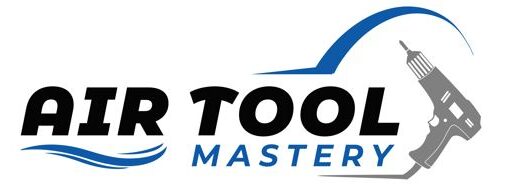Bead Blasting Guns are integral tools that have redefined the surface finishing industry. Bead blasting guns, simply put, are a robust breed of air guns that propel beads at high velocity, towards a particular surface. This action results in meticulously clean, smooth, and polished surfaces, leaving no room for impurities or inconsistencies.
In an era where precision and perfection are highly valued, bead-blasting guns have become an indispensable tool across various industries. From automotive to aerospace, construction to metallurgy, these guns are lauded for their versatility and efficiency. They play a vital role in removing paint, rust, or other surface pollutants, thereby ensuring the integrity and longevity of the materials treated.
What is a bead blaster gun?
A bead blaster gun is a specialized tool used in surface finishing processes to clean or prepare surfaces by projecting abrasive media under high pressure. These guns work by forcefully propelling a stream of abrasive beads, such as glass, plastic, or ceramic beads, onto the surface of the object being treated.
The impact of the beads effectively removes surface contaminants, rust, paint, or other coatings, leaving the surface clean, textured, or prepared for further processing like painting or coating. Bead blasting is widely used across various industries, including automotive restoration, metalworking, and aerospace, for its efficiency in achieving a smooth and even surface finish.
What is bead blasting used for?
Bead blasting is employed for a multitude of purposes across different fields, highlighting its versatility as a surface treatment technique. In the automotive sector, it is crucial for removing rust and old paint from car components, restoring them to their original state before repainting or coating. This ensures a smoother and more adhesive surface for the new paint.
In metal fabrication, bead blasting is indispensable for cleaning metal parts, eliminating surface defects, and providing a uniform finish which is essential for the longevity and performance of the parts. Aerospace industries rely on bead blasting for the precision cleaning of aircraft components, where maintaining the integrity and performance of parts is critical.
What is the difference between a sandblaster and a bead blaster?
The primary difference between a sandblaster and a bead blaster lies in the type of abrasive media they use and the finish they provide on the surface of the treated objects. Sandblasters use a gritty material, typically made of silica sand, which is more aggressive and is capable of removing tougher coatings and contaminants from surfaces. This makes sandblasting an ideal choice for heavy-duty rust, scale, and paint removal. However, the aggressive nature of sandblasting can sometimes be too harsh for delicate surfaces, leading to the risk of warping or pitting.
On the other hand, bead blasting employs smoother, spherical beads made of glass, ceramic, or metal as the blasting media. The round shape of the beads ensures a more uniform and gentle treatment, making bead blasting the preferred method for finishing surfaces that require a smooth, clean appearance without altering the metal’s integrity. This technique is especially beneficial for parts that need a satin or matte finish, such as automotive parts, stainless steel items, and aerospace components. The choice between sandblasting and bead blasting ultimately depends on the specific requirements of the surface finish and the material of the object being treated.
What are the disadvantages of bead blasting?
Despite its advantages, bead blasting has some disadvantages that must be considered. One of the main drawbacks is that it may not be as effective for removing heavy build-ups of corrosion or paint compared to sandblasting. This is due to the gentler nature of the beads, which can struggle with more tenacious materials. Bead blasting also requires specialized equipment and materials that can be more expensive than those used in traditional sandblasting.
Care must also be taken to properly dispose of used beads, as some materials can be environmentally hazardous if not handled correctly. Another consideration is the potential for bead blasting to leave behind a residue on the surface of the treated object, which may necessitate further cleaning or treatment before the object is considered finished.
How is bead blasting done?
Bead blasting is performed in a controlled environment using a bead blasting cabinet. This cabinet is designed to contain the beads and the object being treated, ensuring that the process is both safe and clean. The object is placed inside the cabinet, and then the beads are propelled at high speed towards the surface of the object using compressed air or a centrifugal wheel. The operator can control the intensity of the blast by adjusting the pressure of the air or the speed of the wheel, allowing for precision in achieving the desired surface finish.
Safety is paramount during bead blasting operations. Operators must wear protective gear, including gloves, eye protection, and sometimes, full-face masks, to safeguard against flying debris and the inhalation of fine particles. The bead blasting cabinet is equipped with a dust collector, which helps to maintain a clean working environment and minimize the inhalation risks associated with airborne particles.
The result of bead blasting is a clean, smooth, and uniformly textured surface that is free of imperfections. Once the blasting process is completed, the treated object is removed from the cabinet, and any remaining beads are cleaned off.
What is the difference between a blaster and a gun?
The main distinction between a blaster and a gun in the context of bead blasting lies in their design and intended use. A bead blaster typically refers to the overall system used for bead blasting, including the cabinet, air supply, and the media (beads) used for blasting. This system is designed to clean, finish, or remove surface material from objects in a controlled environment.
On the other hand, a bead blasting gun is a handheld tool that directs the abrasive media toward the surface of the object being treated. It is a component of the bead blasting system and is crucial for the precise application of the beads. The gun allows the operator to control the flow and direction of the abrasive media, enabling them to target specific areas of the object or achieve different surface finishes.
What are the two types of blasting?
The primary types of blasting are dry blasting and wet blasting.
Dry Blasting uses air and abrasive materials to clean or prepare surfaces. It’s a widely used method due to its efficiency and the wide variety of abrasives that can be used, ranging from beads to grit. This technique is highly effective for removing contaminants or preparing surfaces for further treatment, such as painting or coating. However, it generates a significant amount of dust, which requires control measures to protect the worker and the environment.
Wet Blasting, on the other hand, incorporates water into the blasting process. This addition helps to significantly reduce the amount of airborne dust produced, making it a safer and more environmentally friendly option. Wet blasting is particularly beneficial when used on surfaces that might be damaged by the dry blasting process. The water acts as a lubricant, reducing the friction and heat generated, which can protect delicate surfaces from warping or other damage.
Does bead blasting remove material?
Bead blasting is fundamentally a surface treatment process that does not aim to remove material but rather to clean or finish the surface of the object being treated. The main purpose of bead blasting is to create a uniform surface by cleaning off contaminants or by smoothing it out. Unlike more aggressive forms of abrasive blasting, bead blasting focuses on maintenance of the object’s integrity. It effectively removes surface deposits, rust, or scale without significantly altering the surface or removing material from the object itself.
What pressure should bead be used for blasting?
The optimal pressure for bead blasting depends on the type of material being processed and the desired finish. Generally, pressures range from 20 to 90 PSI (pounds per square inch). For delicate materials, a lower range around 20 to 40 PSI is often recommended to avoid damaging the surface. Conversely, for more resilient materials or when a coarser finish is desired, higher pressures up to 90 PSI may be employed. It’s crucial to adjust the pressure based on the specific application and outcomes desired, as too high of a pressure can erode the material, while too low of a pressure may be ineffective in removing contaminants or achieving the desired surface texture.
Types of Bead-Blasting Guns
Pressure Blasting Guns
These are the most common models used in industrial applications. With a separate pressure pot for storing the blast media, these guns provide a powerful and constant stream of beads for aggressive cleaning or surface preparation.
Suction Blasting Guns
Unlike pressure blasting guns, suction models utilize the Venturi effect to draw the blasting media into the airstream. While they might be less powerful, they offer more delicate control, making them ideal for precision work on sensitive materials.
Wet Blasting Guns
This model combines water and blast media in a slurry, which is then propelled towards the surface. The inclusion of water reduces dust and can provide a smoother finish, especially on metal surfaces.
Pneumatic Blasting Guns
These guns rely on compressed air to propel the blast media. Known for their versatility, they can work with a range of different media types including glass beads.
Components of a Pneumatic Bead Blasting Guns

Pneumatic bead blasting guns consist of several key components, each playing a crucial role in the overall operation.
The Nozzle
This is the component from where the bead-media is expelled onto the surface. The size and shape of the nozzle determine the pattern and intensity of the blast. A smaller nozzle produces a concentrated blast, ideal for precision work, while a larger one covers a broader area.
The Air Jet
The air jet lies at the heart of the blasting gun, responsible for creating the necessary high-pressure air flow. It draws the blasting media into the airstream and propels it forward at high velocity. The size of the air jet influences the volume of air, and subsequently the amount of bead-media, that can be utilized.
The Blast Hose
The blast hose connects the blasting gun to the media container. Its role is to transport the blasting media from the container to the gun. It’s essential that the blast hose is durable and flexible to withstand the abrasive materials and the pressure at which they’re transported.
The Trigger
The trigger is the control mechanism of the gun. When pressed, it releases compressed air and bead media. The user can control the intensity and duration of the blast by regulating the pressure on the trigger.
The Media Container
The media container holds the bead media for the blasting operation. It’s designed to maintain a constant feed of media to the air jet without clogging, ensuring a smooth and consistent blasting operation.
Media Shape, Size, and Characteristics in Bead Blasting
The bead-media used in bead blasting can vary significantly in terms of its shape, size, and characteristics, which ultimately influence the final outcome of the blasting process.
The Shape
The shape of the bead-media can be round or angular. Round beads are commonly used for peening and cleaning operations, providing a smoother finish. On the other hand, angular media are more aggressive, used for cutting and etching the surfaces.
Size
The size of the bead-media determines the aggressiveness of the blasting operation. Larger beads create a coarse profile on the surface, while smaller beads result in a smoother finish.
Characteristics
The characteristics of the bead-media, such as its hardness, density, and durability, also play a crucial role. Harder media can remove tough contaminants and achieve a more textured finish, while less dense media are better suited for delicate operations where the underlying material must be preserved.
What To Consider When Choosing a Pneumatic Bead Blasting Gun

Conclusion
Bead blasting guns are specialized tools employed in the process of bead blasting, a technique in which small beads of glass, ceramic, or other materials are propelled at a surface to clean, deburr, or finish it.
These guns are distinguishable by their characteristic features, which include an appropriate air pressure mechanism, a compatible nozzle size, a user-friendly trigger mechanism, efficient air consumption, and compatibility with various media types. They are also recognized for their durability to withstand the harsh environment of blasting operations and ergonomic designs for prolonged usage.
The selection of a pneumatic bead blasting gun is a multifaceted process that requires careful consideration of several key factors including air pressure, nozzle size, trigger mechanism, air consumption, compatibility with bead-media, durability, and ergonomics. Each of these attributes contributes to the overall efficiency, effectiveness, and usability of the gun in blasting operations.

